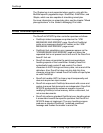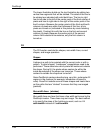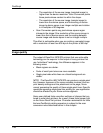
PostScript
Guide to Using Page Description Languages 1-25
Figure 1-5. Example illustrating fill function
This illustration shows four rows of five pixels on the output
device. The center points of the device pixels are at the cross
sections of the dashed lines. The horizontal lines to be filled are
indicated by two solid, bold line segments per horizontal line.
The horizontal line at the top contains the center points of the
second row of pixels; therefore, the pixels are turned on by the
imager. This is shown by cross hatching the pixels that are
turned on. The horizontal line at the bottom of the picture does
not contain the center points of the fourth row of pixels; therefore,
no pixels are turned on, and the line is not visible.
Curved shapes
The flatness parameter is used to set the accuracy with which
curves are rendered on the output device. Because DocuPrint
does not use curve flattening (conversion of curves to line
segments) in graphic rendering, the parameter for the operator
setflat has no effect on the smoothness of curves.
Images
In DocuPrint, the region of the device space to be painted is
determined according to the following rules:
• Scan Conversion paints only those pixels whose centers lie
within the shape if:
Center
Points of
Pixels
Thickness
of Line


















